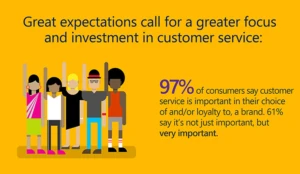
12 Statistics That Show Millennials Expect Even More from Customer Service
While all consumer demographics have increased expectations for customer service, it’s the world’s newest and biggest generation of customers that are creating a seismic rumbling in “I want it my way, I want it now” support.
Millennial customers, commonly defined as the consumer collective born between 1980 and the early 2000s, are collectively expected to spend more than $200 billion annually starting in 2017 and $10 trillion during their lifetime. From music to gaming, to hospitality, retail and real estate, millennials are wielding their purchasing power with higher expectations for engagement.
Millennials extensively research and follow brands online both before and after purchases, making up their own minds about quality, value and customer care via social media, online reviews, communities, the search engines and other avenues, rather than being told what they should think and feel based solely on advertising and marketing messaging.
Microsoft’s new State of Global Customer Service Report confirms that this youngest set of customers is upping the ante for customer service innovation, which is a key part of the customer experience. Take a look at these breakouts by age around areas such as mobile customer service, self-service, social and customer loyalty:
Great Expectations
1. 68% of 18 – 34-year-old consumers have higher expectations for customer service today than they had just one year ago (compared to 56% across all age groups and 47% of consumers ages 55+).
2. 78% of 18 – 34-year old consumers expect a customer service agent to know their contact and product information as well as service history when they contact a brand for assisted service (compared to 72% across all age groups and 66% of consumers ages 55+).
3. 68% of 18 – 34-year-old consumers have stopped doing business with a brand due to a single poor customer service experience (compared to 60% across all age groups and 54% of consumers ages 55+).
Self-service, Mobile and Chat
4. When engaging with a brand or organization for customer service, 65% of 18 – 34-year-olds’ interactions now begin online (compared to 55% across all age groups and 46% of consumers ages 55+).
5. When beginning an online customer service interaction, 36% of consumers ages 18 – 34 start on a mobile device rather than a desktop or laptop computer (compared to 28% overall who start on mobile and 21% of consumers ages 55+).
6. 60% of consumers ages 18 – 34 regularly use live chat for customer service (compared to 45% across all age groups and 32% of consumers ages 55+).
7. 89% of 18 – 34-year-old consumers have used a search engine to try and find the answer to their customer service question (compared to 75% across all age groups and 60% of consumers ages 55+).
8. 84% of millennial customers have used a self-service portal for customer service (compared to 73% overall and 63% of consumers ages 55+).
9. For millennials, 81% have a more favorable view of a brand or organization if their customer service portal is mobile-responsive (compared to just 66% overall and 53% of consumers ages 55+).
Social Customer Engagement
10. Almost half (47%) of consumers ages 18 – 34 have used social media to complain about a brand’s customer service (compared to just 29% overall and 12% of consumers ages 55+).
11. 52% of 18 – 34-year old consumers have used social media to ask a customer service question (compared to 31% of consumers overall and 13% of age 55+ consumers).
12. And if you were wondering if your brand should continue to invest in social media as a customer service channel (or give customer service access to your brand’s social media properties to respond to customer service questions), 64% of consumers ages 18 – 34 say they believe social media is an effective channel for customer service, compared to 45% of consumers overall and 27% of those ages 55+.
The statistics above show where the future of customer service – and customer expectations and preferences – are heading. Is your brand innovating for the next generation?
———————
Get the 2016 State of Global Customer Service Report
 Whether you’re in customer service, marketing, sales, IT – or especially if you’re the CEO, CFO or CDO – you’ll be fascinated by the results revealed by Microsoft’s new 2016 Global State of Customer Service Report which polled 5,000 consumers across Brazil, Germany, Japan, the UK and the US on their customer service preferences and expectations.
Whether you’re in customer service, marketing, sales, IT – or especially if you’re the CEO, CFO or CDO – you’ll be fascinated by the results revealed by Microsoft’s new 2016 Global State of Customer Service Report which polled 5,000 consumers across Brazil, Germany, Japan, the UK and the US on their customer service preferences and expectations.
The variations based on both geography and age will either confirm or totally change the way you think about, invest in, improve and incorporate customer service as a foundation of your brand or organization.
View Microsoft's on-demand webinar discussing this year's fascinating results. With the on-demand webinar, you'll receive a copy of the full 23-page report.




